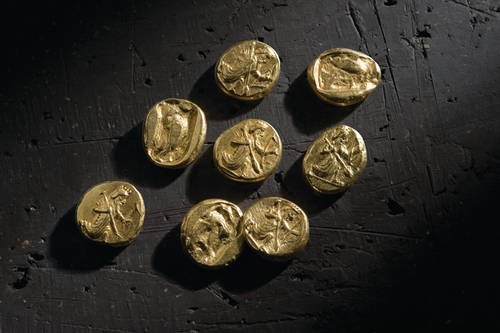Share
"Gold and silver have a unique role in the world, and we should not be so quick to abandon their use in our lives."
Gold has captivated humanity for millennia. Its lustrous beauty, rarity, and intrinsic value have made it a prized asset throughout history. One of the most enduring forms of gold has been gold coins, which have played a pivotal role in the evolution of currencies, trade, and wealth. Join us on a journey through time as we explore the fascinating history of gold coins and their enduring appeal.

Aureus (Greece Gold Coin), Coin hoard which was found in Athens, near Ilissos river. It consisted of 8 gold coins.
The Birth of Gold Coins
Our journey begins in ancient times, around 600 BC, in the kingdom of Lydia, located in modern-day Turkey. It was here that the world's first gold coins were minted. These coins, made of electrum (a naturally occurring alloy of gold and silver), bore intricate designs and denominations. The concept of standardized currency had arrived.
As civilizations like Greece and Rome embraced gold coins, they became symbols of power and prosperity. Roman gold aurei and Greek staters were renowned for their craftsmanship and served as a medium of exchange across vast empires.
Medieval and Renaissance Marvels
During the Middle Ages and the Renaissance, gold coins continued to hold sway. They were used in trade, financing exploration and artistry, and symbolizing wealth and prestige. The Florentine florin, with its depiction of Florence's patron saint, John the Baptist, is a prime example of this era's numismatic beauty.
Colonial Era and Gold Rushes
As European powers expanded their empires, gold coins played a crucial role in international trade. Spanish doubloons and pieces of eight were widely recognized and coveted. The discovery of gold in the New World, particularly during the California Gold Rush of 1848, led to a surge in gold coin production.
Gold Standards and the Modern Age
The 19th century witnessed the adoption of the gold standard, where a country's currency was backed by gold reserves. This era produced iconic gold coins like the British Sovereign and the American Double Eagle. In terms of private gold ownership, the undisputed king was, and still is, the South African Krugerrand. The stability of the gold standard played a pivotal role in global finance until the mid-20th century.
Numismatic Treasures and Collector's Delights
Over time, certain gold coins gained iconic status as numismatic treasures. The 1933 Saint-Gaudens Double Eagle, which was once deemed illegal to own, sold at auction for millions of dollars. Other rare coins, like the 1804 Silver Dollar and the 1907 Ultra High Relief Double Eagle, have also fetched astronomical prices at auctions.

A Gold Krugerrand coin sits on top of lots of American Eagle Silver coins
Gold Coins in Times of Conflict
Gold coins have played a crucial role in times of conflict. During World War II, gold reserves held by nations were seen as strategic assets. The relocation of gold to safe havens and the use of gold coins in clandestine operations are fascinating chapters in the history of gold.
The Modern Collecting and Investment Landscape
Today, gold coins have evolved into highly sought-after collectibles and investment assets. Collectors and investors alike treasure the diversity of gold coins available. From the South African Krugerrand to the American Gold Eagle and the Chinese Gold Panda, these coins offer not only intrinsic value but also historical and aesthetic appeal.
The Krugerrand: A Shining Star Among Gold Bullion
Our journey through time culminates with the iconic South African Krugerrand. Introduced in 1967, the Krugerrand is renowned as one of the world's first modern gold bullion coins. It was created to promote South African gold and has since become a symbol of the nation's rich gold mining history.
The Krugerrand, named after Paul Kruger (a former South African President) and the rand (South Africa's currency), is struck from 22-carat gold (91.67% pure). It features a captivating design, with a profile of Paul Kruger on the obverse and a springbok antelope on the reverse.
One of the Krugerrand's defining features is its absence of a face value, unlike many other legal tender coins. Instead, its value is tied directly to the prevailing gold price, making it a pure and straightforward investment in gold bullion. The coin comes in various sizes, including 1 oz, 1/2 oz, 1/4 oz, and 1/10 oz, catering to a wide range of investors' needs.
Investors worldwide have recognized the Krugerrand's reliability and liquidity. It's easy to buy, sell, and trade, making it a popular choice for those looking to add gold bullion to their portfolios. Its appeal extends beyond South Africa's borders, solidifying its position as a global symbol of gold investment.
The history of gold coins is a remarkable journey through time, from the birth of the first coins in ancient Lydia to the enduring appeal of the South African Krugerrand. Gold coins have transcended centuries, civilisations, and economic systems, retaining their value and allure.
The Krugerrand, with its rich history and status as a gold bullion icon, exemplifies the enduring value of gold coins. Whether you're a collector, investor, or someone simply captivated by the beauty and history of gold.
As you embark on your own journey through the world of gold coins, consider the South African Krugerrand as a shining star in this fascinating history—a symbol of gold's enduring value and the legacy of South Africa's gold mining heritage. It's not just a coin; it's a piece of history you can hold in your hands.







